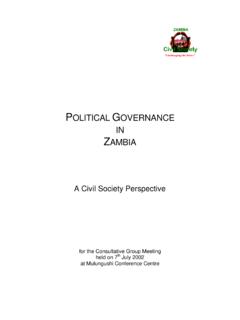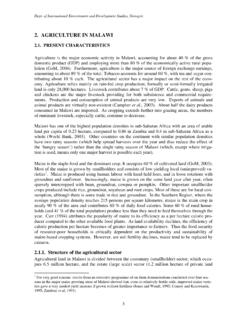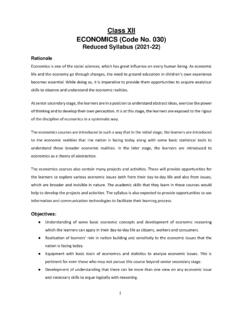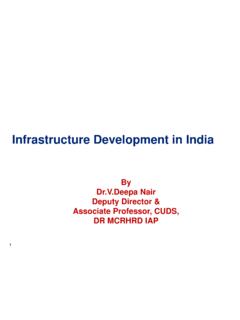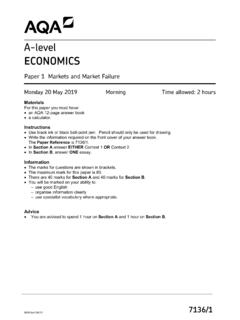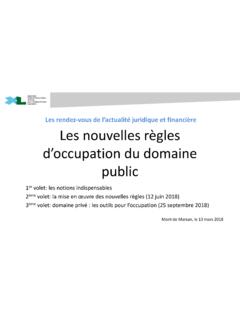Transcription of Chapter 1: An overview of Zambia's economic and poverty ...
1 Chapter 1: An overview of Zambia's economic and poverty situation Introduction poverty is the most profound challenge that zambia faces today. It is a social crisis with the majority of people denied a minimum decent living standard. The latest JCTR (2001) Monthly Food Basket Survey shows that it is becoming more and more difficult for the majority to meet basic needs, because food costs have been rising while wages remain static and too far below the food cost. The gravity of the situation is such that more and more lives are being lost due to hunger, sickness and disease including HIV/AIDS. But what is the definition of poverty ? " poverty is pain; it is like a disease. It attacks a person not only materially but also morally. It eats away one's dignity and drives one in total despair." (World Bank, 2000) From a poor person's perspective, poverty can be described as above.
2 However, there is no single definition for poverty . It is generally agreed, though, that poverty is a phenomenon of many dimensions. poverty is the negation of development; and since development is a multi-dimensional phenomenon, poverty is multi-dimensional as well. poverty differs from one place to another. In the Zambian context it can be defined as deprivation of a long healthy life, educational opportunities, access to resources for a decent standard of living ( income and consumption, housing, health, clean water and sanitation), and lack of freedom to exercise choice and participate in society (MCDSS, 1998a). The purpose of this document is, therefore, to present civil society perspectives on strategies that can effectively reduce poverty in zambia . The contents of the document were arrived at after wide consultation within civil society.
3 Several meetings were held before arriving at these positions. The views presented here will be part of the contribution to the poverty Reduction Strategy Paper (PRSP) process that the Zambian Government is formulating through a wide participatory process. The political and economic context A few years after independence in 1964, zambia was one of the most prosperous nations in Africa. With a rich endowment of arable land, water and mineral resources, it held great potential for sustainable economic development. The new government of the United National Independence Party (UNIP) inherited very poor or inadequate infrastructure, including human capital, from the colonial regime. Initially, the government followed a fairly liberal political and economic policy, primarily focused on providing infrastructure and services to the majority of the people.
4 However, after the implementation of the 1968 Mulungushi Declaration in 1972, the government switched to a more restrictive policy environment, with a heavy role for the state in national development. The state owned and controlled industry, with high tariffs imposed for protection. Consumption was heavily subsidised, prices were controlled and agricultural marketing and credit were provided by state agencies. A booming copper industry, Zambia's economic mainstay, encouraged state controlled policies. In the first ten years after independence, the nation experienced a growth averaging a year, significantly lower than population growth thereby leading to declining per capita incomes. After 1975, zambia faced falling copper prices (initially thought by government as temporal), political turmoil in neighbouring countries and severe effects of the first oil shock.
5 Anticipating a rise in copper prices, the government borrowed heavily to sustain the economy. By the early 1980s, however, it was clear that the 1970s reform had failed. Between 1983 and 1985, therefore, the government attempted an IMF/World Bank Structural Adjustment Programme (SAP) that had stringent conditions attached. This was abandoned in May 1987, after massive food riots on the Copperbelt. SAP was replaced by another local programme that re-imposed the controls of the 1970s. However, the economy continued declining, poverty levels rising and debt swelling to US$ billion by 1991. In October 1991 the people of zambia , discontent with the performance of the reforms thus far, elected the Movement for Multi-party Democracy (MMD) government. The new government pushed liberal policies supported by the IMF and World Bank SAP, in anticipation of a more efficient private sector led economy.
6 The state's role remained the creation of an enabling environment for private business. Trade, exchange rates and interest rates were liberalised, subsidies removed, agricultural marketing liberalised and most parastatals privatised. The invisible forces of the market were to determine prices for goods and services. On the other hand, the state started measures to reduce the blotted civil service to the right size, through retrenchment and voluntary separation. During its first ten years in power, the MMD government has committed itself to implementing these measures even faster than anticipated by other stakeholders. These measures have, however, failed to yield the desired goal - to make the economy grow so as to bring about prosperity in the nation. Instead, economic growth has been sluggish while poverty has continued the upward trend.
7 Discouraged by the inadequate results of these policies, the MMD government has shown signs of retracting some of its earlier commitments. privatisation of the remaining utilities, such as the zambia Electricity Supply Company (ZESCO), is uncertain while media reports indicate that government intention is to designate some of the remaining state enterprises, like the zambia National Commercial Bank (ZANACO), as strategic industries. On the other hand government has introduced stringent interventions in the foreign exchange market to stabilise the depreciating Kwacha. In December 2000, the IMF and the World Bank allowed zambia to qualify to the Highly Indebted Poor Countries (HIPC) Initiative. This means that the nation will now be allowed lower amounts of debt service than otherwise, while the debt stock is expected to be almost halved.
8 Some groups like Jubilee 2000, though, still insist that HIPC debt relief is extremely inadequate and will certainly not solve the debt crisis for poor nations. The poverty situation Today, zambia is among one of the poorest nations in the world. The World Bank classifies zambia as a Least Developed Country. The UNDP Human Development Report 1999 ranks zambia 156 out of 174 countries, having fallen consistently over the past years, from 136 in 1996, to 142 in 1997, to 146 in 1998. Indeed, of 79 countries for which data is available between 1975 and 1997, zambia is the only country where the value of the Human Development Index is lower than it was in 1975. A look at the social indicators reveals a declining trend over time, clearly showing the worsening living conditions of most Zambians.
9 Life expectancy is estimated at 37 years, compared to 42 years at the time of independence (1964) and 54 years at the end of the 1980s. Mortality rates are among the highest in the world. The number of orphans has increased, while a significant proportion of school age (7-13 years) children are not in school (Kelly, 1999). National household surveys conducted by the Central Statistical Office (CSO) in 1991, 1993, 1996 and 1998 use an income poverty line as a measure for poverty . According to the latest statistics, CSO estimates that 73% of the population have incomes below the minimum level determined by CSO. CSO further reveals that the percentage of people living in poverty increased from 70% of the population in 1991 to about 74% in 1993, decreased to 69 % in 1996 and then rose again to 73% in 1998. This measure only shows the proportions of the population that are income poor, but poverty has many other dimensions.
10 According to Seshamani (2000c), people who are income poor need not necessarily be poor in other dimensions of poverty . For example the latest data from CSO shows that 35% of the rural population have access to safe water; hence 65% of the rural population are water poor. 59% of the children are stunted: they are nutrition poor. 27% of the population have not had any schooling at all: they are knowledge poor, and so on. Apart from being a multi-dimensional phenomenon, poverty is also not homogenous. Some people are poorer than others are. zambia faces both high incidence and high severity and depth of poverty (Seshamani, 2000c). According to the Living Conditions Monitoring Survey 1996, the incidence of poverty was nearly 70%, but the intensity was 34% and the depth of poverty was over 50%. According to Seshamani et al.




